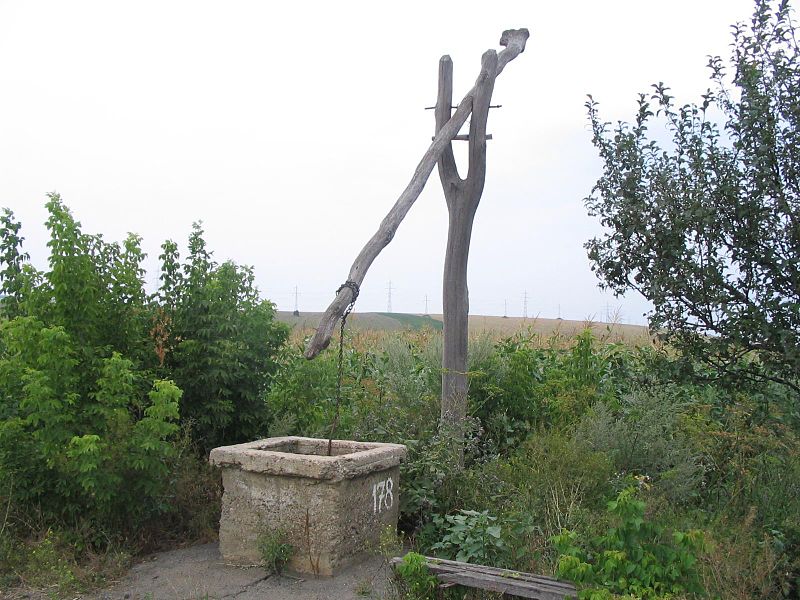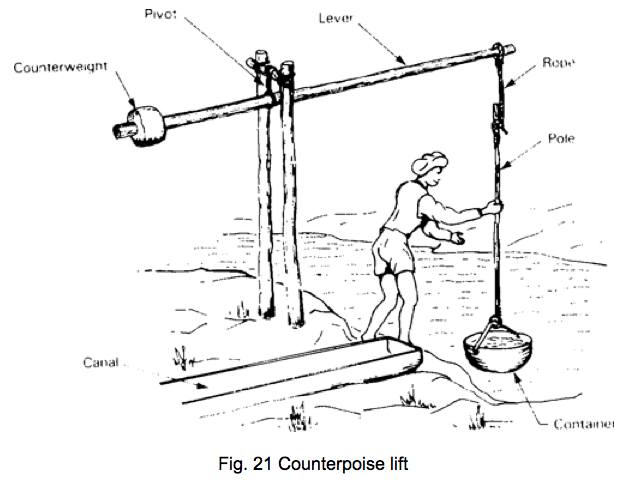Counterpoise lift


Scoop irrigation
Also known as shadoof, shaduf, dhenkli or picottach, the counterpoise lift consists of a long wooden pole and is generally used for lifting water from unlined wells, streams or ponds and for irrigating small fields. A weight, often a large stone or a ball of dried mud or a basket filled with small stones is fixed at the shorter end of the pole to counterpoise the weight of a filled bucket which is attached to the longer arm of the pole with a rope. The bucket is emptied by a sideways tipping motion. This device is used to lift water up to a height of 1 - 3 metres. About 2000 litres of water can be lifted from the depth of 2 to 3 metres in one hour.
Don is also a similar type of device which is used in west Bengal and neighbouring areas to lift water up to a height of 1.2 meters. It consists of a boat shaped trough, closed at one end and open at the other, made of wood or galvanized iron sheets. The trough oscillates on a fixed centre and its closed end is alternately dipped into water and raised. The water flows into the field channel through the open end of the trough.
The pi cottah, used primarily in India, is similar to the shaduf but is operated by two people, one of whom acts as a moving counter weight to eliminate much of the strenuous work of returning the water container against a stationary counter weight. Although it can lift water 5-8 m (16-26 ft), its output is small, and it is used primarily to water small vegetable plots.
Bucket systems may also be adapted to animal power to increase flow, such as with the mohte, or self-emptying bucket. This traditional device employs either a tipping action or simple flap valves in the bucket or bag to discharge the water at lifts of 5-10 m (16-33 ft). The system can be arranged for the animal to walk back and forth in a straight line or in a circle, thus requiring less supervision.
The low-lift dhone, or see-sawing gutters from Bangladesh, can deliver about 300 liters/min (80 gal/min) at a 1 m (3.3 ft) lift. This device uses flap valves and can be operated by a single person shifting the weight back and forth at the fulcrum.
Suitable conditions
The advantage of a counterpoise lift over handpumps is the replacement parts can be acquired locally. Sometimes mechanical handpump parts are more difficult to obtain. They also tend to need a certain amount of preventive maintenance if premature failure of components or impaired performance is to be avoided.1
The counterpoise lift is used extensively in Egypt. It is also common in Nigeria, Southern Niger, and Chad.
| Advantages | Disadvantages |
|---|---|
| - A relatively inexpensive traditional technology, which can be locally made and maintained. - Easy to operate |
- Limited to lifts of less than 4 m - Limited water yield, 60 l/minute, suitable for small fields |
Costs
In Chad, the cost of a shaduf assembled at a well site is US$ 40.
Manuals, videos, and links
- Video: Working Shaduf.
References
- ↑ 4. POWER FOR PUMPING, FAO.
Acknowledgements
- Water lifting devices. Agricoop.nic.in
- Water lifting devices. Inseda.org
- Food from Dryland Gardens - An Ecological, Nutritional, and Social Approach to Small Scale Household Food Production. CPFE, 1991.
- Program on Farmer-Managed Irrigation Systems and Support Services. International Fund for Agricultural Development and the Bundesministerium fur Wirtschaftliche Zusammenarbeit und Entwicklung (BMZ) Government of the Federal Republic of Germany. October 1994. By the International Irrigation Management institute. Colombo, Sri Lanka.
- Jane Olley. HUMAN & ANIMAL POWERED WATER-LIFTING DEVICES FOR IRRIGATION. Practical Action. November, 2008.

